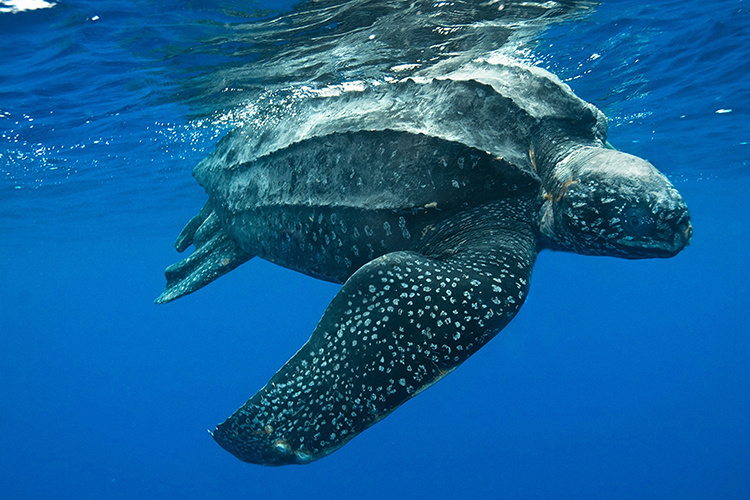By Benjamin Ranelli, Seasonal Biological Science Technician at Cape Hatteras National Seashore (Ocracoke District)
Three quarters of a mile below the surface of the ocean where sunlight cannot reach, true titans still roam the world’s oceans. By far, leatherback sea turtles are the largest sea turtle species and indeed the largest species of any turtle; fully grown adults can weigh over 1,500 pounds and reach over eight feet long. By contrast, even the oldest green sea turtles, the leatherback’s largest hard-shelled relative, rarely grow beyond four feet long and 350 pounds.
Leatherback sea turtles reach their immense size using their specialized beaks to capture jellyfish and other soft-bodied organisms as opposed to other sea turtles whose beaks are shaped primarily to crush the shells of crustaceans or graze on seagrass. Even more unusual, to ensure their prey does not escape their jaws, a leatherback sea turtle’s throat also possesses rows of spines not found in any other turtle. Many of their features are unique compared to other sea turtles because the six hard-shelled sea turtle species are more closely related, belonging to the same biological family: Cheloniidae. Leatherback sea turtles, however, are the last surviving member of a separate family, Dermochelyidae, Greek for “skin” and “turtle.” Just like the name “leatherback,” their family name derives the layer of black, leathery skin concealing their shell— a reminder of their unique evolutionary history.
Leatherback sea turtles are also capable of enduring more extreme environments than other sea turtles, holding the records for the deepest dive, enduring the coldest water and undertaking the longest migrations. To accomplish their extreme feats of survival, leatherback sea turtles rely on several unique adaptations. Their large size, for one, helps reduce heat loss, and their circulatory system is structured to minimize the heat transferred to extremities like the flippers, which dissipate heat quickly. Beyond inspiring the leatherback sea turtle’s name, the collagen fibers in their shells and the leathery skin above it also make their bodies more flexible and able to withstand the intense pressure of deep dives. Though they rarely need to dive over a thousand feet or traverse the Arctic Circle, their bodies are built to endure such harsh extremes if necessary.
Although leatherback sea turtles can navigate frigid waters in search of food, their eggs still require warm temperatures to develop properly, leading females to migrate south to tropical and sub-tropical beaches to nest. Although major nesting sites are centered in Central America, South America and Africa, they may occasionally nest in colder climates, including the coast of France in one rare instance. North Carolina beaches are not typically the preferred nesting habitat of leatherback sea turtles because of their comparatively cooler temperatures, but for the first time in a decade a leatherback sea turtle has nested on Cape Hatteras National Seashore. Despite the large size disparity between leatherback sea turtles and their hard-shelled relatives, they all lay a similar number of eggs; on average each female lays a clutch of 110 eggs in their nest. Compared to more commonly observed loggerhead sea turtles, leatherback sea turtle nests do not require any different protections from the National Park Service in order to thrive.
Despite their capacity to tolerate extreme environments, leatherback sea turtles are still threatened by the rapidly expanding human influence on the environment. Because leatherback sea turtles rely on translucent, gelatinous prey like jellyfish, they are especially susceptible to ingesting lethal, similar looking plastics and other ocean pollutants. Additionally, as oceans warm and jellyfish populations move, leatherback sea turtles must be able to find new migration routes to seek out their prey or risk starvation. Yet perhaps the most devastating threat to leatherback sea turtles is the loss of traditional nesting beaches to rising seas and coastal development. In the face of daunting challenges, maintaining nesting habitat around the world is critical to halting their population decline. It is not yet clear whether a changing climate will make Cape Hatteras National Seashore a more important nesting ground for the leatherback sea turtle, but if these titans of the deep continue to seek a new sanctuary for the next generation, they will find one here.
To learn more about sea turtles at Cape Hatteras National Seashore, visit nps.gov/caha/learn/nature/seaturtles.htm
Benjamin Ranelli is a Seasonal Biological Science Technician working in the Ocracoke district of Cape Hatteras National Seashore. Originally from Connecticut, he began working for the National Park Service after previously conducting research at the University of Connecticut and the Smithsonian Conservation Biology Institute. Working with birds, mammals, and turtles across forests, mountains and seashores, he has dedicated his time to understanding and sharing the incredible diversity of wildlife in the eastern United States.


What is your annual budget amount for the turtle effort?
Hi, Jeanette,
Thank you for your question!
We work with the staff at Cape Hatteras National Seashore each year to determine priority projects, so there isn’t a set budget for the program each year, especially because the number of sea turtle nests varies year to year. Any funds raised but not spent in a given year carry over to be used for the next year’s priority projects at the Seashore.